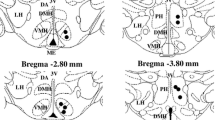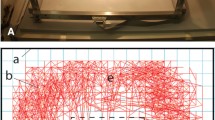Abstract
A test situation was developed in which the effects of drugs on habituation of exploratory behavior (head-poke responses) could be assessed independently of their effects on general activity (locomotion and rearing). Habituation, spontaneous recovery from habituation and stimulus specificity of habituation were studied.
An amphetamine-barbiturate mixture attenuated habituation of the head-poke response without influencing general activity. Pro-Leu-Gly-NH2 (PLG), an oxytocin fragment, increased locomotor activity and did not alter the course of habituation of the head-poke response. Since exploratory behavior and general activity can be pharmacologically dissociated in the test situation used, it is concluded that the test situation is suitable for studying the effects of drugs on habituation of exploratory behavior. The amphetamine-barbiturate mixture did not influence the stimulus specificity of habituation of the head-poke response. Fenfluramine however increased the effects of stimulus change on the head-poke response while not influencing habituation of this response. These results show that habituation and stimulus specificity of habituation of exploratory behavior can be pharmacologically dissociated.
Similar content being viewed by others
References
Clineschmidt BV, Totaro JA, McGuffin JC, Pflueger AB (1976) Fenfluramine: long-term reduction in brain serotonin (5-hydroxytryptamine). Eur J Pharmacol 35:211–214
Cooper SJ (1976) Exploratory response habituation and the attenuating effect of an amphetamine-barbiturate mixture. Psychopharmacology 49:91–96
Feigley DA, Hamilton LW (1971) Response to novel environment following septal lesions or cholinergic blockade in rats. J Comp Physiol Psychol 76:496–504
Feigley DA, Parsons PJ Hamilton LW, Spear NE (1972) Development of habituation to novel environments in the rat. J Comp Physiol Psychol 79:443–452
File SE (1975) Effects of parachlorophenylalanine and amphetamine on habituation of orienting. Pharmacol Biochem Behav 3:979–983
van Ree JM, Bohus B, Versteeg DHG, De Wied D (1978) Neurohypophyseal principles and memory processes. Biochem Pharmacol 27:1793–1800
Robbins TW (1977) A critique of the methods available for the measurement of spontaneous motor activity. In: Iversen LL, Iversen SD, Snyder SH (eds) Handbook of psychopharmacology, Vol 7. Plenum Press, New York, pp 37–77
Rushton R, Steinberg H (1963) Mutual potentiation of amphetamine and amylobarbitone measured by activity in rats. Br J Pharmacol 21:295–305
Williams JM, Hamilton LW, Carlton PL (1974) Pharmacological and anatomical dissociation of two types of habituation. J Comp Physiol Psychol 87:724–732
Williams JM, Hamilton LW, Carlton PL (1975) Ontogenetic dissociation of two classes of habituation. J Comp Physiol Psychol 89:733–737
Author information
Authors and Affiliations
Rights and permissions
About this article
Cite this article
Koek, W., Slangen, J.L. Habituation of the head-poke response: Effects of an amphetamine-barbiturate mixture, PLG and fenfluramine. Psychopharmacology 72, 251–256 (1981). https://doi.org/10.1007/BF00431825
Received:
Accepted:
Issue Date:
DOI: https://doi.org/10.1007/BF00431825




